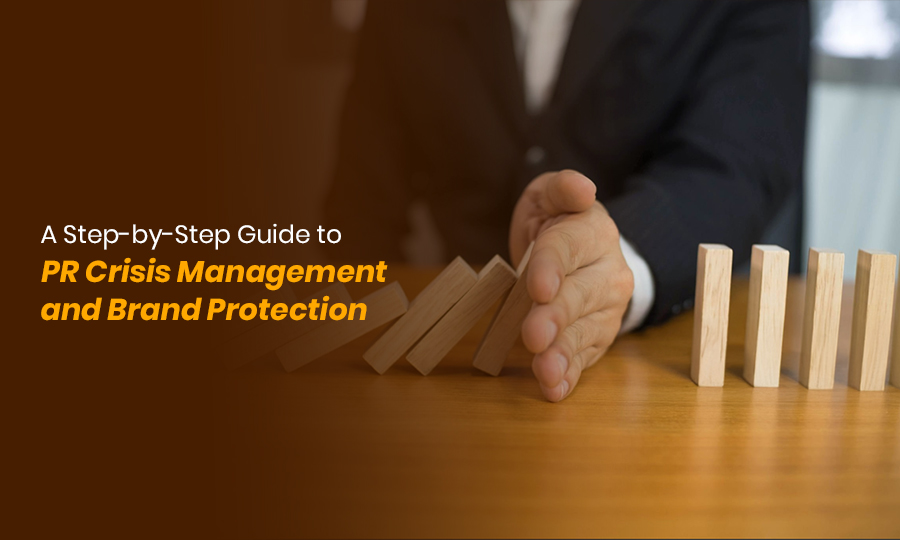PR CRISIS – a phrase that every brand is frightened of! Even a well-managed company can face massive loss if struck by a public relations crisis. But when a PR disaster can occur, no one knows. And when it does, it can damage a brand’s reputation in minutes. That’s why it’s crucial to prepare a robust PR crisis management plan in advance to address a crisis and prevent reputational damage.
According to the 2019 PwC Global Crisis survey, nearly 7 in 10 (69%) leaders have experienced at least one corporate crisis in the last five years.
Any business can face a public relations crisis at some point, but how they respond quickly to such critical situations determines whether they get a much-needed public image boost or damage their brand reputation even more.
From a typo in the email marketing campaign to a full-blown international scandal can result in a massive public relations crisis. In today’s competitive era, brands need to be prepared with solid strategies to promptly and efficiently respond to a PR crisis.
In this blog, we’ll provide you with a complete guide to effectively managing a PR crisis and protecting your brand reputation. Let’s get started!
What is PR Crisis Management?
It refers to the steps that a business takes to handle a public relations emergency and protect its brand reputation through effective communication with the public. In simple words, public relations crisis management is about preparing a brand to reduce the negative impact of major events that can threaten its business reputation and harm its relationships with stakeholders and the general public.
Wondering what can be a PR crisis? The following are some events that can lead to a PR crisis –
- A major data, health, and safety breach that causes harm to customers or employees
- A product or service quality issue
- A product recall
- Employee misconduct
- An unfavorable social media post
- Negative news going viral
- Old service mishaps suddenly start appearing online
- Terrible online reviews
- Legal claims against the brand or owners
- Discrimination on the grounds of religion, race, and gender
- Engagement in activities that cause damage to the environment
No matter what the nature of the event is, if it encourages negative press, it is more likely to affect your brand image and result in a loss of public trust.
Who is in the defense? Brands can hire PR agencies or PR professionals who will be the first line of defence for them. The PR crisis management team will inform the brands about the –
- Ongoing crises
- Its potential risks
- Planned actions to mitigate the risks
- The messages that need to be conveyed to the brand’s target audience
Public relations crisis management works in three phases: identifying potential threats, preparing responses, and performing effective communication with the public during crises.
The goal?
It aims to maintain a brand’s stakeholders’ trust and prevent its reputational damage. From handling negative news articles to fixing customer service issues and conveying the right messages, successful public relations crisis management covers all the best practices.
How Is PR Crisis Management Related to Brand Protection?
PR crisis management and brand protection – these two terms are closely associated. Want to know why? Let’s understand it in detail.
Have you ever thought about why it’s important to manage crises? The answer is to protect an organization’s reputation and public image.
PR professionals work on safeguarding their clients’ brand reputation and overall value. Brands can restore public trust by preventing long-term negative impacts on their image.
In a nutshell, effective public relations crisis management strategies can positively transform the way the general public perceives a brand during a crisis.
Conversely, a strong brand, when built on a positive public image and customer loyalty, can better handle the pressure of a PR crisis and make the crisis management process more manageable with its knowledge and expertise. You can consider public relations crisis management an effective tool to protect a brand from a maligning reputation.
When Crisis Hits
Imagine a healthcare brand is facing a massive PR crisis due to its poor-quality products that have caused harm to a few customers. So what will be their first thought when such a crisis occurs?
The company will definitely want to protect its brand reputation and win back its customers’ trust. On the other hand, a brand with a positive reputation is expected to be better equipped to handle an unexpected public relations crisis. Then they can effectively prevent the server impact of the crisis and make the recovery process smoother.
Major Reasons Why PR Crisis Management Is Important
Are you among those who think you’ll prepare a good crisis management plan when a crisis hits your brand?
You’re highly mistaken!
A crisis can hit your business anytime and cause reputational damage overnight. Thus, you must be prepared with a robust public relations crisis management plan beforehand, so that you can address the issue at the right time and mitigate the risk before any severe damage to your brand reputation.
Apart from this, public relations crisis management matters for a few more significant reasons. Let’s have a look!
- Protects your brand reputation – We’ve already discussed how crisis management strategies can protect a brand from reputational damage due to a PR crisis. Effective public relations crisis management protects your brand’s image. Through the processes, you can promptly address the PR issue and reduce the impact of negative publicity.
- Encourages customer trust – Have you lost your loyal customers because of a public relations crisis? No need to worry! If you develop impactful crisis management strategies, you can rebuild your customer confidence in your credibility and demonstrate reliability. Maintaining public trust and loyalty is an added benefit.
- Reduces the risk of financial loss – One of the major damages a PR crisis can have is massive financial loss to a brand due to reduced customer loyalty. According to a 2025 report by Accounting Times, a company’s share can drop by 35.2% on average due to a reputational crisis. A well-managed crisis can help you prevent negative impacts on your overall sales and revenue. Furthermore, you can protect your market share and minimize financial repercussions.
- Demonstrate corporate responsibility – How will your customers and consumers react if they see that your brand has taken no major step during a PR crisis? They’re more likely to consider your brand as irresponsible. Yes, you heard that right! On the other hand, if they see you’re making significant, informed decisions to better handle a crisis and address the issue with multiple dedications, it’ll showcase your employee responsibility and dedication towards serving customers better.
Examples of the 9 Major Types of PR Crisis
One thing you must remember is – A PR crisis can occur at any time, and even from the smallest issue.
We hope that now you will face no difficulty in identifying a PR crisis and addressing the issue beforehand. Because if you fail to identify the crisis, your efforts for Pr crisis management will be of no use!
Still have doubts? Here we’ll provide you with some examples of the nine major types of PR crises to help you effortlessly identify those and prepare a robust crisis management plan beforehand.
- Product or Service Failure
Imagine a company has sold bad-quality products and provided poor customer service, which has caused significant harm to its customers and has eventually become a PR issue.
Example: A car production brand’s faulty car model leads to recalls, a food brand has sold a defective batch of food that has caused illness, and a popular software with major glitches can also be considered a product or service failure.
- Cyber Crime
This is one of the most significant PR crises a business can face. It can cause severe reputational and financial damage to a business if not handled tactfully.
Example: Cyber issues like hacking incidents, cybersecurity vulnerabilities, ransomware attacks, and customer data breaches that have exposed sensitive information.
- Ethical Scandals
Is your brand performing well on ethical grounds? If not, then it can result in a public relations crisis.
Example: A company authority’s unethical behavior, bribery, labor exploitation, or environmental violations can lead to a PR crisis and reduce public trust in it.
- Workplace Related Issue
If the employees of your company face some workplace-related issues, it can lead to a PR crisis.
Example: Employees can commonly experience discrimination, harassment, discrimination, or poor treatment from other senior or other employees at the workplace. All these can lead to negative publicity and employee backlash. The employees can even share their negative experiences online, which can become a PR crisis, damaging the company’s reputation.
- Data Breaches
Is your company’s database compromised or hacked? If yes, it can lead to a major PR crisis, resulting in reduced customer trust in your brand’s credibility and reliability.
Example: A hacked database that has exposed crucial company or customer data, or even financial details.
- Poor Customer Communication
Every brand, no matter if it is a market leader or a start-up, must excel in customer communication. Nowadays, consumers have many choices in terms of brands, so they’re more likely to scrutinize even the smallest aspects of a brand before they purchase anything. Thus, poor customer communication can lead to a full-blown public relations crisis.
Example: If your brand fails to respond to customers’ complaints, provide accurate information, or offer poor customer service, it can lead to customer disappointment and damage your brand’s public image.
- Negative Media Coverage
Sometimes, journalists and media channels cover negative news about brands. When reputed media channels convey a negative message about a brand, most people tend to believe it without finding the truth. Such negative media coverage can lead to negative online search results about the brand, which is itself a major public relations crisis.
Example: Media channels often cover unfavorable news stories, negative investigative reports, post negative articles, or share critical reviews about businesses. All these can negatively influence public perception about the brand.
- Social Media Backlash
It’s quite common for brands to experience social media controversies because of a variety of issues. Excessive social media backlash can transform into a major PR crisis.
Example: Are you receiving negative comments from your followers on your brand’s social media page? Or are there negative memes about your poor-quality products going viral on social media? Are negative hashtags related to your brand trending on popular social media platforms? If all the answers to these questions are YES, it can be a sign of an upcoming PR crisis.
- Legal and Regulatory Issues
Last but not least, legal issues can be a PR crisis for your business as well. It can even escalate further and lead to serious legal consequences.
Example: Violations of laws, regulations, and your company policies are some major examples of legal issues that can damage your brand reputation and result in a public relations crisis.
Top 10 PR Crisis Management Strategies to Protect Your Brand Reputation
Do you have a robust plan to effectively manage your PR crisis? If not, it’s time to create one!
Creating a public relations management plan is not optional! A 2025 Global News Wire study has revealed that 70% of businesses don’t have a public relations crisis management plan. And the statistics are scary!
When a business is hit by a PR crisis, but the authorities don’t have a crisis management plan, it can have more severe impacts on its brand reputation. To prevent this risk, we’ve provided you with a complete list of the top 10 proven PR crisis management strategies. Let’s check it!
- Build a Crisis Communication Plan

The first step is to decide what you should do. To create a checklist, you can document your strategies to outline how your brand will respond and act quickly during a public emergency.
Always outline these three aspects –
- Who will respond?
- How will they respond?
- When will they respond?
It will help your team to quickly respond when a PR crisis occurs. An effective crisis communication plan includes the following responsibilities, such as –
- Decide the roles and responsibilities of your PR team members
- Create pre-approved message templates
- Plan decision-making procedures
- Determine stakeholder notification protocols
- Create clear communication channel guidelines
- Measure the success of your efforts
Note: You can divide a crisis period into three phases: Pre-crisis, During the crisis, and Post-crisis.
The pre-crisis period requires you to plan how you’ll handle a PR crisis, while you need to execute your plan when the crisis hits your business. When the crisis is over, you need to recover from the reputational damage caused by the crisis.
Take a quick look at the three major practices to create a public relations crisis communication plan.
- Identify a Crisis
What has led to a public relations crisis for your business? It’s crucial to identify the crisis and its source to plan the immediate action. A true crisis goes beyond your regular online reputation management issues.
For example, you have received a negative review from an unhappy customer. This is not a major PR crisis and can be managed with effective strategies for handling negative reviews.
Let’s classify it into three different types, so that you can identify a crisis seamlessly.
- Level 1 (not a crisis) – You’ve received isolated complaints with limited reach.
- Level 2 (Concern) – The negative reviews are increasing day by day, and it requires your strategic response. Otherwise, it has the potential to transform into
- Level 3 (Crisis) – There are hardly any positive reviews, as your online profiles are now full of negative reviews about your brand. It is a significant threat to your brand reputation and requires immediate crisis plan execution.
Once you reach the third level, it’s time to equip your team members and activate your crisis response plan.
- Select and Train a Suitable Spokesperson
Now the question comes – who will speak to the general public on your brand’s behalf, or represent your brand during a crisis?
You need to train your team members to make them learn what and how to act during a public relations crisis. Select someone from your team who is capable enough to be the spokesperson and encourage the public to keep trust in your brand. It’s important to choose the right person for this role, as he/she will be the first point of contact for your customers.
Who can be the spokesperson during a PR crisis? Your customer service or social media team can take up the responsibilities to communicate with the public first after a crisis hits your business. While the customer service team can directly interact with your customers, the social media team can post crisis-related updates and make them reach a wider audience, even the media. They can even address a potentially viral negative opinion circulating on social media beforehand.
Apart from them, you can also hire a team of communication specialists. If the crisis escalates, you must involve the following team members –
- CEO
- Employee with legal expertise
- Media communication specialists
- Stakeholder communication experts
- Customer service representatives
- Tech lead members
The entire team will ensure your PR crisis communication runs smoothly and your brand recovers from the public relations crisis.
- Craft the Right Message
Before you share a public statement, you need to craft the right message. Even the smallest inaccurate information can escalate the crisis further.
Communication plays a huge role in a public relations crisis – whether the public will keep trusting your business largely depends on what you respond and how you respond. It’s a vital part of a PR crisis management plan.
Here are some key points to remember while crafting your message.
- Be honest and transparent while crafting your message; accept the liability straightaway to showcase your commitment towards your customers.
- Never showcase that you’ve something to hide or aren’t concerned about the crisis.
- Don’t blame any external parties; always explain how you’re striving to improve the situation.
- There are many ways you can address an unfortunate situation with a different tone of voice and language. You need to choose a way that is suitable for the unique situation.
Fact: Every crisis doesn’t require the same response, as it often doesn’t go well with the people involved in that PR crisis.
Now, it’s time to craft your first public move after a crisis occurs.
Firstly, assess what you know about the public relations crisis –
- Is it all right not to publish a public statement in this situation?
- Do you have confirmed and valid facts about the PR crisis?
- How much time will it take to investigate thoroughly?
- Should you stop posting on social media and running marketing campaigns for a while?
Based on these examinations, you can craft an appropriate response. If you need time to investigate, you can publish a Holding Statement.
What is a Holding Statement? It’s a short and prepared message, generally used during a crisis to acknowledge the event and reassure the other stakeholders. Brands can also request the public and stakeholders to give them enough time to investigate a matter.
- Identify the Affected Ones

Apart from your business, your customers, investors, and stakeholders can be affected by the public relations crisis. You need to identify the affected ones following these steps –
- Assess the crisis – You need to swiftly evaluate the scope and impact of the public relations crisis occurred. It will help you identify the people who have been affected by the issue.
- Communicate with utmost empathy – You can express genuine concern for the people impacted by the crisis through a written statement. When you communicate with empathy with the affected ones, it will build their trust in you and show your accountability.
- Personalize your response – Try to understand the specific needs and concerns of your stakeholders and customers. This way, you can tailor your crisis response in a way that resonates well with them. Crafting a personalized response is an effective online crisis management strategy.
- Take the Responsibility

Are you afraid to commit that a mishap has actually happened from your brand’s end?
You shouldn’t be! Taking responsibility for the crisis will showcase that you are running away from your mistakes. It’s a great strategy to keep your loyal customers on your side even after a crisis.
For example, your brand has provided defective luxury collection clothes to a celebrity, which has resulted in a massive PR crisis. Instead of denying the incident, you must own up to the mistake that happened from your brand’s end. This may save you from losing a celebrity client!
What to do?
Without being defensive, you can communicate with those who are affected because of the situation. You can convey your message to them, highlighting how your brand is taking necessary steps to resolve the issue at the earliest and assure them that such things will not happen in the future from your end.
Instead of communicating on your own, you can designate spokesperson on your brand’s behalf to ensure all communication is accurate and consistent.
- Monitor the Crisis

Unless and until you have every possible information about the crisis, you cannot take effective actions to mitigate the damage. Thus, it’s crucial to closely monitor the crisis to understand which strategy can resolve your crisis.
Follow these steps to monitor your public relations crisis.
- Track Your Brand Mentions
You can use tools like Mentions or Google Alerts to get notifications whenever your brand gets an online mention. It’s best to track what is being said online about your brands, its products, and services. The nature of brand mentions will showcase the overall sentiment of the public and the media regarding your brand.
- Adapt Your Strategy
We suggest you constantly monitor the crisis and always be prepared to adapt your crisis communication strategy and messaging. Based on the circumstances involved, you can adapt different crisis communication strategies.
- Analyze the Data
Have some data about the crisis? We suggest you analyze the existing data to understand the potential severity of the public relations crisis and its scope as well. Always determine the likelihood and effect of different risk factors.
- Identify Vulnerabilities
A PR crisis management will not be successful if a brand fails to identify its weaknesses and potential vulnerabilities to unique threats. You can create a list of the most negative scenarios that can happen due to the crisis to plan the strategies well in advance.
Tools You Can Use to Monitor Your Crisis
The following are some helpful tools that you can use for specific practices to ensure the success of your crisis monitoring.
| Tool Name | Purpose of Using |
| Sprout Social, Mention, Brandwatch | For monitoring social listening and sentiment analytics, tracking social media brand mentions, and crisis sentiment |
| Hootsuite | For managing multiple social media accounts and monitoring social media mentions |
| Google Alerts | To get instant notifications for online brand mentions, negative online sentiment spikes, or related keywords |
| ServiceNow and D4H | For using comprehensive incident management features and seamlessly managing emergencies, to craft an effective crisis response |
Apart from these tools, you can also monitor news websites, blogs, and other popular media outlets to monitor mentions. Furthermore, monitoring the customer reviews can help you identify potential issues in your brand.
A Bonus Tip! You can gather valuable customer feedback through surveys, help tickets, Q&A series, and even social media live sessions.
- Convey Your Message to the Media

After deciding on your crisis response strategy, you need to craft an effective message to address the crisis properly. How you’re pitching to the media plays a huge role here. The media people must be influenced by your reason to convey a crisis message to the public.
The following are some effective tips to convey your message to the media.
- Be specific – Always be specific and clear while conveying your message to the media. You shouldn’t over-explain your story and avoid corporate jargon or language.
- Communicate clearly – You need to clearly communicate what happened and what steps you’re taking to resolve the issue.
- Show genuine emotions – You should show genuine empathy and acknowledge the issue that has caused harm to your customers, employees, and stakeholders.
- Take responsibility – Take the responsibility for your part without blaming anyone. You must provide the details of the specific steps that you’re taking, not just what you’ll do someday.
- Match your tone of voice – Always ensure that the way you’re conveying your message, the tone of your voice, aligns with the seriousness of the situation. You shouldn’t be overly casual while talking about a significant PR crisis issue.
- Monitor your Social Media Channels

A majority of customers are more likely to engage with a brand on social media during a crisis because most companies share crisis updates on popular social media platforms like Facebook and Instagram.
Have you prioritized monitoring social media channels during a crisis and even before a crisis hits your brand?
If not, you must consider social media reputation management strategies to effectively monitor how your followers are perceiving your brand on social media.
Here’s a social media monitoring checklist for you! Let’s have a look.
- Expand your keywords – You can include additional keywords related to the public relations crisis that occurred, other than the branded ones. You can use hashtags, phrases, and slogans to track how your social media posts are appearing.
- Increase the frequency of monitoring – Scan the popular social media platforms more frequently to receive instant updates about the social media comments and mentions.
- Prioritize platform – There is a wide variety of social media platforms, but you need to observe which platform your followers are expressing more negative outrage on.
- Monitor influencers – The social media influencers that work on your brand niche and can sway public opinion. You never know who can help you positively transform the negative public perception about your business.
- Check the volume of mentions – You should track if your social media brand mentions are growing or decreasing. This will help you identify how your brand is perceived on social media during a PR crisis.
- Track false information – It’s crucial to find out on which social media platform misinformation about your brand is circulating and address it promptly.
- Manage Public Sentiment

What the general public is thinking about your brand during a crisis?
Have no idea? Then, you’re missing out on some crucial data!
Any brand needs to monitor public sentiment, especially before a public relations crisis. It’s a significant part of PR crisis management. When you create an effective crisis management plan beforehand, it requires you to track public sentiment, as most PR crises show warning signs before they explode.
Why is it important? Identifying those signs and potential risks can help you take necessary precautions beforehand and reduce the negative impact of the crisis. When you regularly monitor how the general public is perceiving your business, it allows you to prepare for your crisis response in advance.
For example, if you own a cosmetic brand named ‘XYZ’, then you can track –
- Direct brand mentions like ‘XYZ’
- Product name mentions like ‘poor quality brightening moisturizer’
- Mentions of executives and marketing campaigns like ‘CEO statement on improving product quality’ or ‘Friends for your skin campaign’
- Overall sentiment changes, like you can look for sudden drops in positive public sentiment
- Industry-specific keywords related to the crisis, like ‘data breach’ of prime members of the XYZ website
You can also track the conversion happening about your brand on online and offline platforms to understand the public sentiment. Real-time online sentiment tracking can also help brands detect crisis indicators.
Additional Tip: Whenever you find any concerning patterns in the public sentiment, you need to identify whether you’re experiencing a genuine public relations crisis that requires immediate action.
- Leverage Technology for Efficiency

In today’s digital era, various technological advancements have sped up the process of efficiently responding to a PR crisis. Without using appropriate technologies, the process was quite slow, and often the brands failed to prevent the massive reputational damage.
With technology: But leveraging technology has increased efficiency and helped businesses respond to a crisis swiftly and mitigate the risk before the crisis can significantly harm their businesses.
Here is how you can effectively use technology for public relations crisis management.
- Social listening:
You must keep track of the online conversations for your brand mentions and related keywords. It will help you detect signs of potential crises like increasing negative reviews, comments, or mocking memes. We’ve already talked about tools like Mention and Brandwatch that you can use to ensure the success of social listening.
- AI-powered assistance:
Brands can use AI-generated tools to perform important tasks like media and public statement drafting, key message identification, and sentiment analysis.
- Rapid communication platforms:
We suggest you create channels for quick information dissemination to your internal teams, the general public, and the media outlets. Some examples of such platforms include a brand’s dedicated social media accounts, your company’s intranet, and email distribution lists.
- Data analysis:
The data you’ll collect from social listing and other related sources can be used to understand the PR crisis’s impact and customize your crisis response to ensure the maximum impact.
- Create Official Statements and Public Apologies

Once you’re done communicating with the media, it’s time to craft an official statement and a public apology. Additionally, it’s crucial to distribute those statements across multiple communication and distribution channels.
Is there any specific platform from which the crisis originated?
If yes, then you should focus on that specific platform, as a majority of people are waiting for your first response after the crisis occurred. You must share your official statement across –
- Your website, where you can create a dedicated page or separate blog posts to share your complete statement
- Emails where you can have direct communication with your customers, stakeholders, and subscribers who are affected by the PR crisis
- Executive platforms, like LinkedIn, where you can share statements of the CEO or CMO of your company, for additional credibility
- Internal channels to update employees immediately about the crisis and the steps you’re taking to mitigate the risk
- Media outlets to share your public apology or official statement with relevant journalists and reporters
- Influencers (who can represent your brand to the general public) to make your official statement reach a wide audience
A Public Apology Can Work Wonder During A Crisis.
If the fault is at your brand’s end, you must publicly apologize for the damage your brand has caused to the customers and stakeholders. It’s not about saying a little ‘SORRY’, but for not meeting the expectation of your customers and maintaining their trust and confidence in your service.
Examples of Public Apologies in PR Crisis Management
The following are some examples of public apologies that you can take reference from.
- To acknowledge the issue –
“We understand that there has been a serious product quality issue from our end that has affected our customers. We take full responsibility for this incident.”
- To express your sincere regret –
“We’re deeply saddened by the inconvenience caused to our customers and stakeholders due to a major data breach that unfortunately occurred from our brand’s end.”
- To explain the situation –
“We would like to inform you that we’re currently investigating the incident of workplace discrimination that happened and will share our findings and final verdict as soon as possible.”
- To outline corrective actions –
“We’ve already implemented some major changes in the shipping policy and product safety measures. Additionally, we’re working with an expert team to prevent similar future occurrences. We’re happy to inform you that we’ll provide the complete refund and complimentary access to our premium services for the next 6 months to those affected.”
- To invite customer feedback –
“We welcome your feedback and encourage you to reach out to our team if you have any queries or concerns regarding the situation.”
- Post-crisis Brand Rehabilitation

Once the crisis is resolved, the most important period is when a brand implements strategies to regain the trust of its customers.
The process must include the reassessment of the brand’s corporate positioning. Demonstrating genuine concern for the well-being of the affected ones through a sincere apology and taking complete responsibility for the damage that the crisis caused is a great idea, though!
Note: Brands should always maintain an open and consistent communication with stakeholders across various channels. Always remember, honesty is the best policy! Take actions that are visible to the public; taking significant steps without informing the affected ones is of no use during a public relations crisis.
Effective PR crisis management allows your customers to guide the recovery process by expressing their feedback post the crisis about how well a brand has handled the massive crisis, and the brand is successful in preventing major damage by taking the right steps.
A mistake shouldn’t happen twice!
After the crisis is resolved, a brand should ensure that it takes the necessary measures to prevent such PR crises in the future. It must define a new and more relevant brand position in its niche industry and reflect new commitments to deliver the best possible customer service.
What Not to Do in A PR Crisis?
Till now, we’ve discussed what you can do during a PR crisis and handle the situation better. Here we’ll talk about what you shouldn’t do during a crisis – as these practices can actually make the situation more complex and even cause more damage to your brand’s public image.
Have you reacted emotionally to a public relations crisis?
Did you not publicly apologize?
Have you blamed your employees for all your financial loss due to a crisis?
Note: These are the things that you SHOULDN’T DO during a PR crisis! Below, we’ve provided a checklist for you – Don’ts you must consider during a PR crisis!
- Never lie about your mistakes during a PR crisis faced by your business. Lies can quickly erode your customer trust, so maintaining transparency is crucial.
- Shifting blame to the employees or others is a common practice that many brands engage in when in a public relations crisis. You shouldn’t run away from acknowledging the mistakes and taking ownership of the situation.
- You must not offer a delayed response to the crisis, as it can make the situation even worse. A brief acknowledgement can work during a crisis, but not a slow response!
- Don’t ignore the importance of planning a PR crisis management plan. Always have a plan regarding how you will manage everything when a PR crisis hits your brand.
- Never react emotionally to negative reviews, unfavorable news articles, and social media criticism.
- You shouldn’t go silent during a crisis! Silence from your brand’s end can be misinterpreted as indifference or guilt. Imagine you being silent when people and the media are blaming your brand for providing defective products to the customers. Weird right?
- Never over-defend yourself, especially if your business is at fault. It can escalate the situation and make it seem like you’re not taking responsibility for the mishap.
- Are you afraid to apologize publicly? You shouldn’t be; a sincere public apology can improve the crisis and showcase your concern about your customer experience with your business.
- Don’t try to minimize the problem; rather, address the PR issue head-on. It will showcase your brand’s commitment to resolving an issue at the earliest.
- You shouldn’t ignore your stakeholders during a crisis! Your internal and external stakeholders must be informed about the whereabouts and feel supported from your end throughout the PR crisis.
2 Major PR Crisis Management Examples
Below, we’ve talked about some major examples of public relations crisis management.
- Balenciaga’s Teddy Bear Controversy
The popular brand Balenciaga launched an advertising campaign that featured some children holding teddy bears dressed in a cloth that appeared to be bondage gear. The campaign was launched in November 2022.
The advertisements immediately sparked social media outrage. Many started accusing the luxury brand of sexualizing children and promoting inappropriate content.
Crisis Response: At first, they refused to take responsibility and filed a lawsuit. But later, they changed course and issued a public apology, specifically after receiving intense backlash throughout the week. Balenciaga’s CEO described the incident as ‘grievous error’ and announced new content validation procedures. The controversial advertisement got removed from every platform as well.
Damage: The brand lost almost 100,000 Instagram followers and fell out of Lyst Index’s top 10 fashion brands.
- Delta’s Upside-down Plane Landing Incident
On 17 February 2025, Delta Connection Flight 4819, flying from Minneapolis to Toronto, experienced a catastrophic landing incident. The incident took place when the aircraft’s right landing gear fractured upon touchdown during severe winter weather.
It caused the plane to flip upside down and catch fire when it was on the runway. Fortunately, all 80 people on board survived; however, 21 were injured, including three major ones.
Crisis Response: Delta immediately activated emergency protocols and successfully evacuated all the passengers. The brand provided immediate medical care for the injured. Furthermore, they offered $30,000 compensation to the passengers with no waiver of legal rights.
The brand maintained regular updates through multiple communication channels and completely cooperated with the Transportation Safety Board of Canada’s investigation.
Damage: Delta’s prompt and generous approach towards the crisis was widely appreciated by media relations experts. The compensation was seen as a gesture of goodwill and a smart public relations strategy. The crisis management strategy helped them minimize the fallout and maintain customer loyalty.
Conclusion
A PR crisis can hit a business anytime, sometimes without any significant sign. What matters here is how the brand responds to the crisis and handles the situation proactively. Just like any other marketing tactic, it also requires brands to implement effective strategies to ensure the success of PR crisis management.
We hope that our comprehensive guide will help you learn the skills to handle public relations crises effectively and prevent the massive damage to your brand reputation.
If the process seems complex to you or you lack an expert team, you can consider hiring an online reputation management agency to elevate your brand’s public image and stand out in today’s competitive age.

